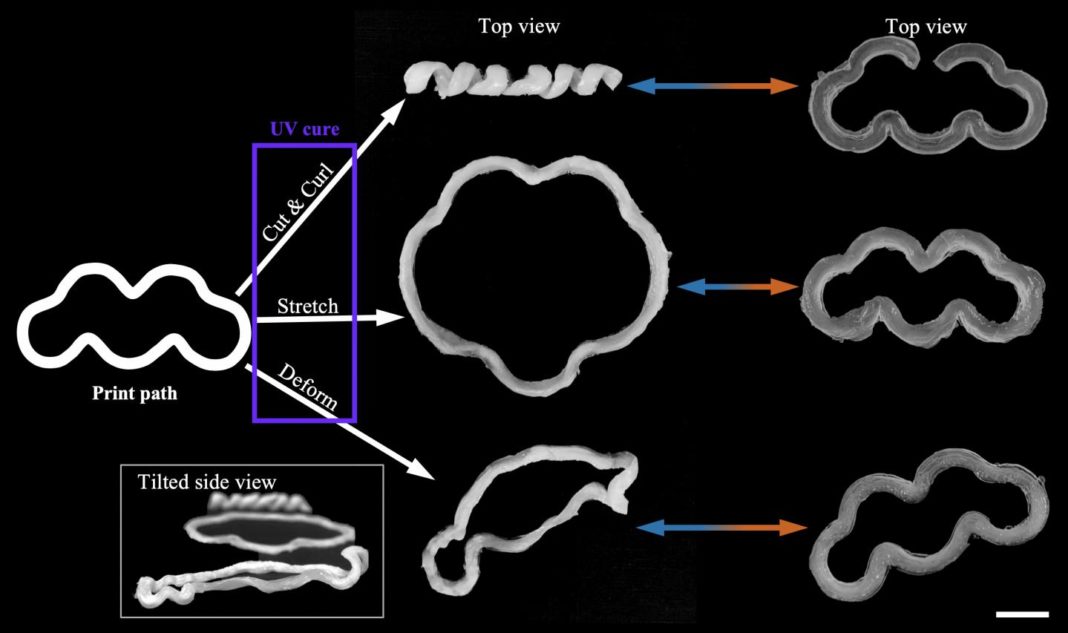
Shapeshifting materials produced at Rice University with a 3D printer morph from their original form to an alternate through changes in temperature, electric current or stress. This example shows how one printed configuration can be programmed to take various shapes. [Verduzco Laboratory/Rice University]
Soft robots and biomedical implants that reconfigure themselves upon demand are closer to reality with a new way to print shapeshifting materials, according to scientists. Now, Rafael Verduzco, PhD, and graduate student Morgan Barnes of Rice’s Brown School of Engineering say they have developed a method to print objects that can be manipulated to take on alternate forms when exposed to changes in temperature, electric current, or stress.
The researchers think of this as reactive 4D printing. Their work “Reactive 3D Printing of Shape Programmable Liquid Crystal Elastomer Actuators” appears in the American Chemical Society journal ACS Applied Materials and Interfaces.
“3D printing stimuli-responsive materials that reversibly actuate between programmed shapes is promising for applications ranging from biomedical implants to soft robotics. However, current 3D printing of reversible actuators significantly limits the range of possible shapes and/or shape-responses because they couple the print path to a mathematically determined director profiles to elicit a desired shape change,” write the investigators.
“Here, a reactive 3D printing method is developed that decouples printing and shape-programming steps, enabling a broad range of complex architectures and virtually any arbitrary shape changes. This method involves first printing liquid crystal elastomer (LCE) precursor solution into a catalyst bath, producing complex architectures defined by printing. Shape changes are then programmed through mechanical deformation and UV irradiation.”
“Upon heating and cooling, the LCE reversibly shape-shifts between printed and programmed shapes, respectively. The potential of this method is demonstrated by programming a variety of arbitrary shape-changes in a single printed material, producing auxetic LCE structures and symmetry-breaking shape changes in LCE sheets.”
They first reported their ability to make morphing structures in a mold in 2018. But using the same chemistry for 3D printing limited structures to shapes that sat in the same plane. That meant no bumps or other complex curvatures could be programmed as the alternate shape.
Overcoming that limitation to decouple the printing process from shaping is a significant step toward more useful materials, Verduzco said.
“These materials, once fabricated, will change shape autonomously,” he pointed out. “We needed a method to control and define this shape change. Our simple idea was to use multiple reactions in sequence to print the material and then dictate how it would change shape. Rather than trying to do this all in one step, our approach gives more flexibility in controlling the initial and final shapes and also allows us to print complex structures.”
The lab’s challenge was to create a liquid crystal polymer “ink” that incorporates mutually exclusive sets of chemical links between molecules. One establishes the original printed shape, and the other can be set by physically manipulating the printed-and-dried material. Curing the alternate form under ultraviolet light locks in those links.
Once the two programmed forms are set, the material can then morph back and forth when, for instance, it’s heated or cooled.
The researchers had to find a polymer mix that could be printed in a catalyst bath and still hold its original programmed shape.
“There were a lot of parameters we had to optimize—from the solvents and catalyst used, to degree of swelling, and ink formula—to allow the ink to solidify rapidly enough to print while not inhibiting the desired final shape actuation,” Barnes said.
One remaining limitation of the process is the ability to print unsupported structures, like columns. To do so would require a solution that gels just enough to support itself during printing, she said. Gaining that ability will allow researchers to print far more complex combinations of shapes.
“Future work will further optimize the printing formula and use scaffold-assisted printing techniques to create actuators that transition between two different complex shapes,” continued Barnes. “This opens the door to printing soft robotics.”


